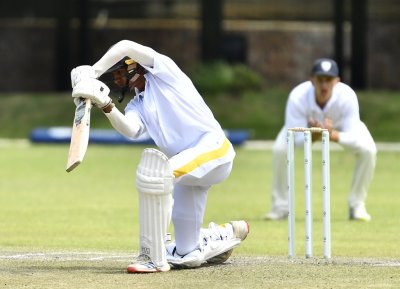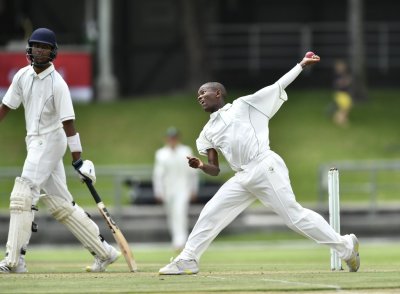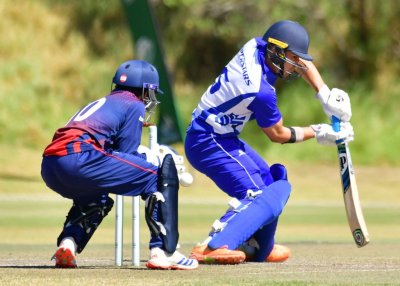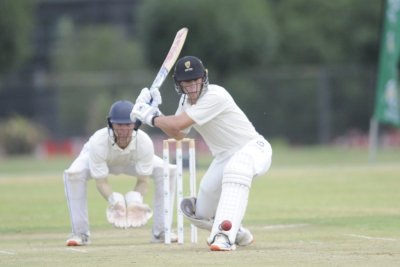Player Profile: Joe MacRobert (St John’s College)
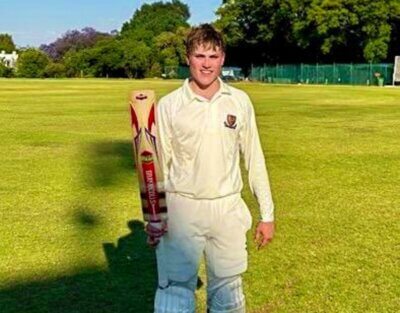 Joe MacRobert had watched from behind the stumps as Armaan Manack and Matthew West scythed through his bowlers. It was a blood bath. The St John’s College captain deployed eight bowlers to try and stem the flow of runs, but all looked impotent against the duo. They scored a combined 265 as they catapulted St David’s Marist Inanda to 346 in their 50-over-a-side match.
Joe MacRobert had watched from behind the stumps as Armaan Manack and Matthew West scythed through his bowlers. It was a blood bath. The St John’s College captain deployed eight bowlers to try and stem the flow of runs, but all looked impotent against the duo. They scored a combined 265 as they catapulted St David’s Marist Inanda to 346 in their 50-over-a-side match.
“They are about 30 runs short,” Bongani Ntini, the St John’s coach, told MacRobert during the innings break.
In 2006, Jacques Kallis walked into a dispirited South Africa dressing room after Australia had scored a mammoth 434/4 in the fifth one-day international at The Wanderers and remarked that the visitors were about 20 runs below par. Everyone agreed that the pitch was good for batting, but Kallis’s comment solidified the belief that 434 was not an impossible total to chase. South Africa scored 438 to win with a ball to spare and make history.
Ntini’s comment had a similar effect on MacRobert. It assured him that the task before him was not unattainable. With his mind freed from the fear of failure, he walked out to bat with one thing on his mind, “Go and have fun”.
That’s what his father, Gus, always told him before matches or tours. “What we have always said to him is go and have fun. Especially on tours, we tell him to go and enjoy the time with friends and meet new friends,” Gus shared.
MacRobert had fun, smashing an unbeaten 183 from 101 balls to lead his team to a six-wicket victory with a mind-boggling 10.4 overs to spare. St John’s had scored 350/4 in 39.2 overs.
*********************************************************************************************
Gus MacRobert has an ESPNcricinfo footprint, and that is not by accident. After completing his studies at the University of Cape Town, where he played first XI cricket, Gus enrolled at Oxford University. He also represented the famous university in cricket. His batting was serviceable and his medium pacers troubled batters enough for him to be picked for the Combined Universities team that competed in the Benson and Hedges Cup during the 1995 county cricket season.
His wife, Georgie, played SA Schools hockey and senior women’s provincial hockey. Their first two children, Roxy and William, were upgrades of their talents. Roxy played first-team hockey at St Mary’s School, Waverley, and was Victrix Ludorum in athletics, while William was an all-rounder during his time at St John’s College.
Joe, three years William’s junior, is an amalgamation of everyone’s talents at home, in part, because of the genes. It’s also because of the sporting environment in which he has been raised. Roxy’s and William’s sports equipment were his first toys. His older siblings were also his first opponents.
“We tried to make our backyard contests as tough and interesting as possible. We would set difficult fields and targets for each other. William would always try to assert dominance over me,” Joe MacRobert shared.
To be competitive against older siblings, younger siblings have to work a little harder than when they play against their peers. In childhood, a three-year gap is a long time. The disparity of strength, speed, and skill is immense.
“Essentially, the challenge of playing up – playing with older siblings who tend to be bigger and stronger and so on – accelerates their skill acquisition,” says Tim Wigmore, co-author of “The Best: How Elite Athletes are Made”.
“His hand and eye coordination and contact points were excellent. Joe was always a step ahead of other kids in his age group,” Vincent Jordaan, who coached MacRobert from u9 at St David’s Prep recalled.
It is a distinction Jeff Levin, the current St David’s Marist Inanda head coach, also noticed when he first came into contact with MacRobert at St David’s Prep. “I coached Joe with three of his school friends from grade 0 for a few years. They were a very talented group and I had them playing with a hard ball within a couple of sessions. While they were all very talented, Joe stood out as a natural, whether he batted, bowled, or even kept wicket.”
Both coaches said MacRobert made playing cricket look easy. He had no trouble understanding and executing what they asked him to try. When they asked him to bowl spin, he landed the ball accurately and spun it. When he kept wicket, he was light on his feet and consistently cleanly pouched the ball. With the bat, “his balance and positions were excellent and his ball striking was phenomenal,” as Levin described it.
Neither coach was surprised when MacRobert scored his maiden century for St David’s Prep at u9 level.
*********************************************************************************
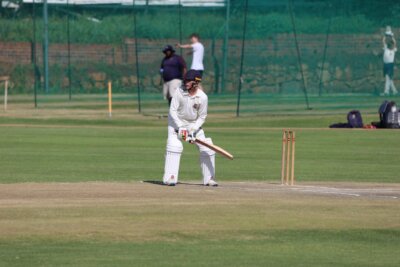
“I lost interest in cricket when I was in Grades 8 and 9. Covid-19 happened and then when we came back a lot of my friends had dropped cricket,” MacRobert revealed.
It also didn’t help matters that he returned a few low scores. Suddenly, without friendly voices encouraging him to keep going, the crease and the changing room felt lonely.
Richard Williams, the father of tennis legends, Venus and Serena Williams, has a public image that resembles that of Earl Woods, Tiger Woods‘ father. Both men are portrayed as hard-driving taskmasters who made their offspring into megastars by dictating their development. However, there is a rarely spoken about side of both parents. They let their children lead.
There is a scene in the movie “King Richard”. A famous coach tells Richard that if Venus, then 11 years old, doesn’t play more matches, “you’re going to ruin her”. Richard responds by pulling Venus and Serena out of the junior tennis circuit completely.
“They don’t need all that pressure,” Richard told the coach. “They need to just be kids.”
For the next three years, Venus didn’t play an official match. While Richard Williams saw that his daughters were exceptionally talented, he refused to drive them onto the tennis court. He wanted them to pursue the sport because they loved it. That is the mindset Gus MacRobert adopted with Joe.
While he knew of his son’s abilities, he resisted the urge to send him for private coaching. Instead of playing in winter leagues, MacRobert played other sports in the cricket offseason. In the summer, he didn’t just focus on cricket, he also played tennis and golf.
“We’ve never really had any deep chats about Joe’s cricket. We never analyse his games, innings, or what he could have done better. That’s not to say we don’t pay attention to his performances. No. We go to every match, support him all the way, and chat about some stand-out performances,” Gus said.
Gus and Georgie’s message to Joe has always been, “Go and have fun”. They urge him to enjoy the time with his friends and to meet new friends. So, when MacRobert fell out of love with the game, they were not taken aback. He went for six months without picking up a bat and no one batted an eyelid. When he picked it up towards the end of Grade 10, MacRobert scored big.
“I scored two centuries in a week, one was a 150 in a T20 match against St Benedict’s, and the other an unbeaten 100 at the Gauteng trials. That felt good and I started finding joy in the game again,” MacRobert shared.
**************************************************************************************
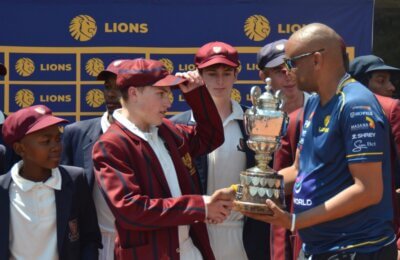
He has always looked up to two players, Quinton de Kock and Kumar Sangakkara. He emulated Sangakkara’s elegant cover drives, but has a technique similar to De Kock’s. In fact, his favourite bat as a youngster was an old GM he picked up because De Kock used one like it. He was in Grade 5.
Like the two international stars, he is a left-handed batsman who keeps wicket. “I only started keeping wicket in 2023, when coach Bongani Ntini asked me,” MacRobert said.
He hasn’t wanted to put down the gloves since then. Wicketkeeping isn’t the only skill Ntini has helped MacRobert add to his bag of tricks. The St John’s College coach has also helped the 18-year-old develop a more attacking game.
“Joe’s technique didn’t need any tweaking when I started working with him in 2023. Our training was focused on him to be more aggressive,” Ntini explained. “The dominating nature has always been there, but it was more on the shot selection side of things, when to switch on and when to switch off.”
Coach and student spent a lot of time practicing range-hitting, upskilling him on picking off a good length over midwicket, bringing in slog sweeps and switch hits, not only to spin bowlers but also against medium pacers.
The results have been outstanding. During the 2023 season, MacRobert scored 1 258 runs in 33 innings at a strike rate of 109.97. He was a lot quicker in the 2024 season, with 1 077 runs in 28 outings at a strike rate of 137.9.
“I enjoy taking on bowlers and pushing the game ahead. I will do it as long as it helps the team,” MacRobert said.
His commitment to the team’s effort is probably why his favourite match out of the 100 innings he has batted in for St John’s was the 42 runs he scored against St Stithians to help his team win the Johnny Waite title on 2 March 2024.
“That’s Joe MacRobert, a team player through and through. He always does what is needed by the team,” Ntini said.
- SA Schools cruises to win over SA Fillies - 2025-12-19
- Mieke van Voorst to lead SA Schools - 2025-12-19
- Lourens and Van der Vyver end CSA Girls u19 Week on a high - 2025-12-18



